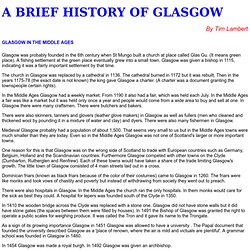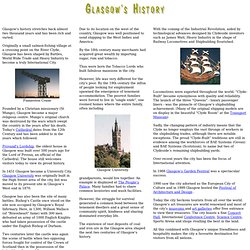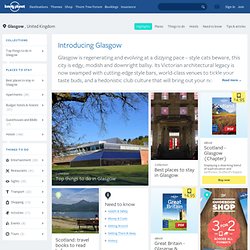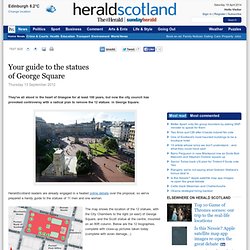

Timeline of Glasgow history. Glasgow History. Scottish Screen Archive - Search - Results. A History of Glasgow. Glasgow was probably founded in the 6th century when St Mungo built a church at place called Glas Gu.

(It means green place). A fishing settlement at the green place eventually grew into a small town. Glasgow was given a bishop in 1115, indicating it was a fairly important settlement by that time. The church in Glasgow was replaced by a cathedral in 1136. The cathedral burned in 1172 but it was rebuilt.
In the Middle Ages Glasgow had a weekly market. There were also skinners, tanners and glovers (leather glove makers) in Glasgow as well as fullers (men who cleaned and thickened wool by pounding it in a mixture of water and clay) and dyers. Medieval Glasgow probably had a population of about 1,500. One reason for this is that Glasgow was on the wrong side of Scotland to trade with European countries such as Germany, Belgium, Holland and the Scandinavian countries.
Dominican friars (known as black friars because of the color of their costumes) came to Glasgow in 1260. Home. Historic Glasgow - Local History. Glasgow has a rich and diverse Local History.

Glasgow's History. Glasgow's history stretches back almost two thousand years and has been rich and varied.

Originally a small salmon-fishing village at a crossing point on the River Clyde, Glasgow has been shaped by Battles, World Wide Trade and Heavy Industry to become a truly International City. Finnieston Crane Founded by a Christian missionary (St Mungo), Glasgow became a major religious centre. Mungo's original church was destroyed by the wars which swept the country in the years after his death. Today's Cathedral dates from the 12th Century and has been added to in the years which followed. Glasgow Life Home. TUNNELS UNDER GLASGOW. As befits a city containing over a million inhabitants, Glasgow is served by two ordinary underground railways and a tube, as well as by a remarkable tunnel system under the docks and the River Clyde.

It is, however, not altogether surprising that Glasgow should have obtained her first underground railway over twenty years after London, for in proportion to the size of the place, the Glasgow streets are more regular and better planned, at any rate on the north side of the river, than those of London. London, too, was the pioneer where underground transport was concerned, and many cities watched results in London before committing themselves to similar enterprises.
Glasgow rests on geological strata of considerable variety, and the builders of her underground communications were faced with difficulties unknown to those who dug their way through the unchanging London clay. Beneath Glasgow they had to contend with anything from hard rock to quicksand. Work on the "Covered Way" Glasgow Travel Information and Travel Guide - Scotland. Glasgow is regenerating and evolving at a dizzying pace – style cats beware, this city is edgy, modish and downright ballsy.

Its Victorian architectural legacy is now swamped with cutting-edge style bars, world-class venues to tickle your taste buds, and a hedonistic club culture that will bring out your nocturnal instincts. Best of all, though, is Glasgow’s pounding live-music scene which is one of the best in Britain, and accessible through countless venues dedicated to homegrown beats. The city is going through a long-term transformation, evident along the revitalised River Clyde, where visitors can explore Glasgow’s mighty maritime heritage along riverfront walkways. Glasgow Guide: Glasgow Maps: Map of Central Glasgow.
Subway. Your guide to the statues of George Square. HeraldScotland readers are already engaged in a heated online debate over the proposal, so we've prepared a handy guide to the statues of 11 men and one woman.

The map shows the location of the 12 statues, with the City Chambers to the right (or east) of George Square, and the Scott statue at the centre, mounted on an 80ft column. Below are the 12 biographies, complete with close-up pictures taken today (complete with avian damage...) 1. Thomas Graham: (B Listed, erected 1872 by William Brodie, cast by R Masefield and Son of Chelsea) Glasgow-born Graham (1805-1869) was a brilliant experimental chemist, who pioneered laboratory-based chemical education at Glasgow University.
His studies on the diffusions of gases resulted in 'Graham's Law and his discovery of dialysis is still used in many medical facilities today. 2. 3. 4. 5. 6. 7. 8. 9. 10. 11. 12. Contextual targeting label: Clyde Waterfront Education: educational resources about the River Clyde area. Wellington Statue, Glasgow. Statue of Wellington, mounted.

Outside the Gallery of Modern Art, Queen Street, Glasgow, Scotland; June 2010 Duke of Wellington statue, with cone The equestrian Wellington Statue, most often featured with a traffic cone on its head, on Royal Exchange Square in Glasgow, Scotland, is one of the city's most iconic images. In 2011 the Lonely Planet guide included the monument to Arthur Wellesley, 1st Duke of Wellington in its list of the "top 10 most bizarre monuments on Earth", along with the Rocky Balboa statue in Žitište, Serbia and the Washington National Cathedral in the United States.[1] Located outside the Gallery of Modern Art and forming an end to Ingram Street the equestrian statue of the Duke of Wellington by Italian artist Carlo Marochetti, was erected in 1844.
Challenge to cone practice[edit] References[edit] See also[edit] Coordinates: Glasgow Defence Campaign. George Galloway. Glasgow City Council Homepage. Glasgow. Coordinates:

The Glasgow Web Site. Home.